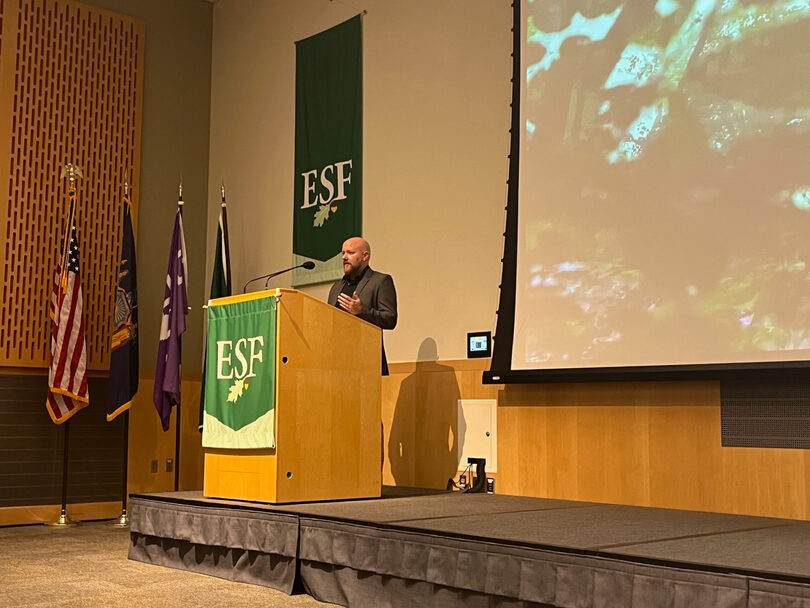SUNY ESF employs virtual reality to envision a sustainable climate

Alex Burstein | Contributing Writer
Aidan Ackerman showed the audience how the software he built is used over the course of his hour-long presentation, including how the technology has the potential to help with things such as managing invasive species and providing training for marking trees.
Get the latest Syracuse news delivered right to your inbox.
Subscribe to our newsletter here.
In a matter of seconds, Syracuse University doctoral student Kerry McNamara was transported from the lobby of SUNY ESF’s Gateway Center to a vast forest landscape. Minutes later, she was back in the lobby.
“It was so immersive,” McNamara said. “I actually felt like I was there, which was a little trippy, but it was very fun.”
McNamara was experiencing one of Aidan Ackerman’s virtual forests, a program three years in the making that uses virtual reality to recreate forests and demonstrate what a more sustainable climate future could look like. On Thursday, Ackerman, an assistant professor of landscape architecture at ESF, got the chance to present his work to around 150 spectators at the Gateway Center as part of the Dale L. Travis Lecture Series.
The software — which currently uses video game software Unity and may soon be moving to Unreal Engine — uses virtual reality technology to both recreate and reimagine new and existing forest scenes.
Over the course of his hour-long presentation, Ackerman showed the audience how the software he built is used and what questions it may be able to answer in the future.
The program can visualize forests after natural disasters or be used to imagine new greenspaces in cities. The technology has the potential to help with things such as managing invasive species and providing training for marking trees, Ackerman said.
“We’re trying to do something that is not very common,” he said.
Tanner Laramee, a second year master’s student in landscape architecture at ESF, worked on a project over the summer using Ackerman’s software to re-imagine the I-81 viaduct partly as an urban forest.
“(The technology is) very limitless,” Laramee said. “It can move in so many directions. It’s very beneficial, not only on the architecture, landscape architecture side, but you know, when you start getting into ecology, really anything.”
Another student who worked with Ackerman examined acid rain in the Adirondacks throughout history using the software.
“(When) he inputted into our virtual reality visualization software, (it) actually showed us the change in the sort of cloudiness or fogginess in the atmosphere to reflect the changes in sulfate deposition, which are trending positively due to mitigation efforts,” Ackerman said.
Dale Travis, a 1959 ESF alum who has funded the series since 2013, also attended the lecture. Ackerman’s presentation particularly stood out to him for its beneficial uses of virtual reality, Travis said.
Travis said he developed the lecture series after hearing a presentation at the New York Botanic Gardens in New York City on the Chestnut Program, a group Travis is part of, dedicated to restoring the chestnut tree population.
“They were so well attended, and it dawned on me that ESF must have a lot of professors whose work is going on behind the scenes, and it would be nice to give it a chance to be publicized and let the public know what’s happening,” he said.
The series has allowed ESF faculty to showcase their work in 13 different lectures since 2013, according to the lecture series website. In Ackerman’s case, that meant sharing his virtual forest, which also includes work with students at ESF.
Outside of the Syracuse area, the technology has been used in projects across the country, including with organizations like the National Park Service Olmsted Center for Landscape Preservation and American Forests.
During the presentation, Ackerman also showed recreated locations from around the state that lack greenery and redesigned them with a full tree canopy. He hopes the program can help people better connect to nature.
“(We’re) really thinking about the whole picture of what the next 50, 100 years are going to look like,” Ackerman said. “I’d love to have this become a normal way of working when we start to talk about environmental policy.”





